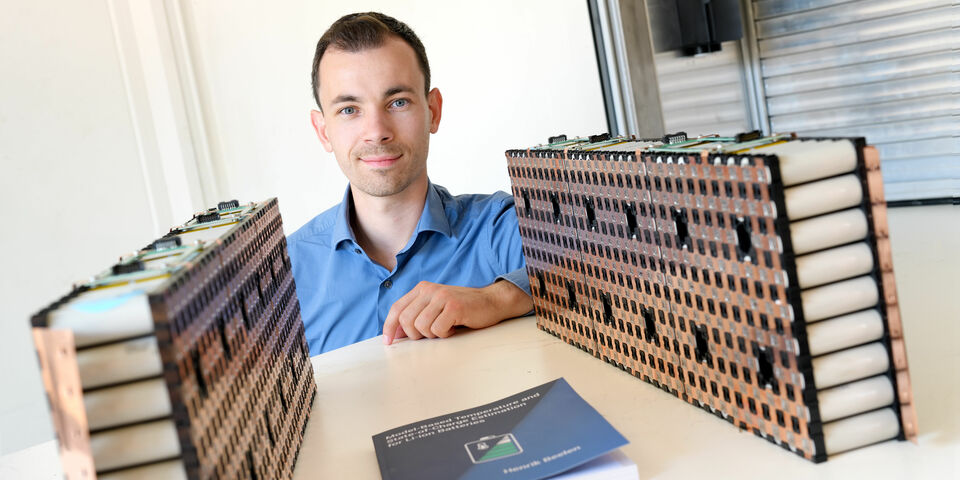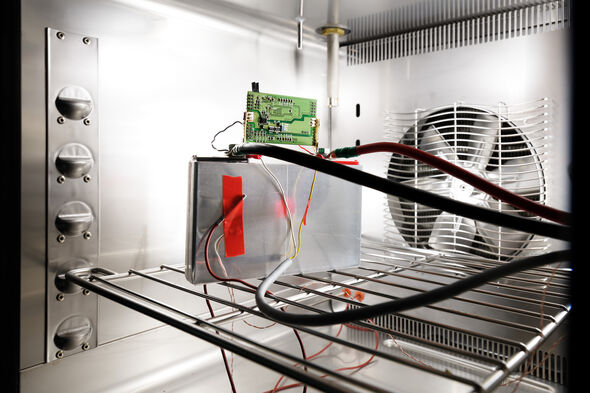Home Stretch | Shining a new light on batteries
We are becoming increasingly dependent on rechargeable batteries: many people worry constantly about the state of charge of their smartphone, and it seems only a matter of time before we will all be driving electric cars. PhD candidate Henrik Beelen developed a method to measure the temperature within these batteries. To improve safety, and to measure the battery’s state of charge more accurately.
The batteries in both smartphones and electric cars are based upon lithium-ion technology, says Henrik Beelen, who took his PhD at the Control Systems group (Electrical Engineering). “Virtually every rechargeable battery today is of this type, including the ones in laptops, e-bikes, hearing aids and pacemakers.” With all these important applications, it goes without saying that you want to make the best possible estimate of the battery’s state of charge, and you also want to know how to use them in a sustainable and safe manner.
To start with safety: accidents occur sometimes because the lithium-ion battery catches fire, Beelen says. “When the temperature inside rises too high, it causes chemical processes that can get out of hand.” That is why every battery is equipped with a temperature sensor, he explains. “Including the one in your smartphone.”
The so-called battery management system that is connected to each rechargeable battery uses information about the temperature condition to establish the amount of residual charge, and it will shut down the device if it detects signs of overheating. “I left my iPad in the burning sun once and it gave a warning sign before it went to black, exactly as it was supposed to.”
Infancy
The problem is that such a temperature sensor is, out of necessity, located on the battery’s outside, while the temperature on the battery's inside is more relevant. However, there is an alternative way to measure the internal temperature. The temperature inside the battery influences the electrical resistance; this makes it possible to indirectly determine this temperature by sending a small current through the battery and measuring the resulting voltage. This method was still in its infancy, according to Beelen. “It had been used already, but its accuracy, for instance, was still unclear.”
Essential for this measuring method is, obviously, to establish which measured resistance goes with which internal temperature: each battery therefore needs to be calibrated. For this, Beelen used a special ‘climate chamber’ where he could adjust the temperature from -40 to 150 degrees Celsius. Setting up this measuring system on the sixth floor of Flux proved to be quite a difficult task, Beelen says. “Of course, everyone here walks around with batteries in their smartphones and laptops. But as soon as you start to measure batteries, you suddenly trigger every alarm. That is why it took years before the system was set up.”
It has to be said that the climate chamber isn’t just used to measure batteries ‘in rest position,’ but also during a realistic usage. And since Beelen’s project was part of a European project on batteries for electric cars, this meant simulating a standard driving cycle, which involves currents of dozens of amperes. That is why the cabinet is connected to some serious power electronics.
Beelen also developed a new algorithm to estimate the state of charge and eventually combined this with his temperature measurements. A fully charged battery has a different resistance than an almost empty one, that is why the temperature estimate is also linked to the battery’s state of charge. In addition, the ageing of the battery also plays a role, as does the question whether the battery is in use, especially in an electric car that races along the road at full speed. “These aspects are all connected,” he says, “and that makes the whole process very complex.” That is why Beelen considers his work to be an important step forward, although his method isn’t ready for implementation yet. His research will therefore be continued within Control Systems.



Discussion